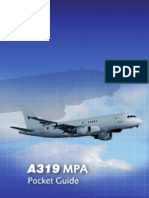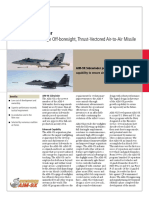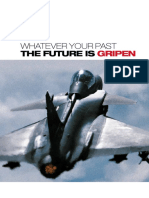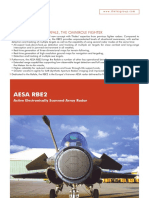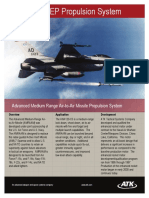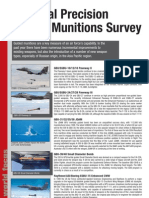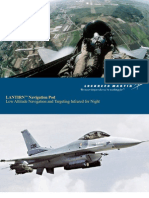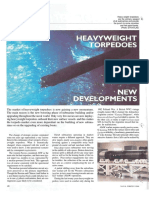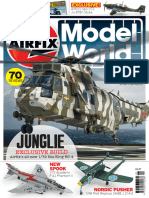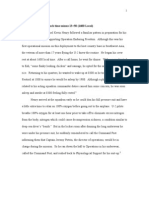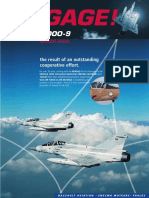0 ratings0% found this document useful (0 votes)
383 viewsScenema M88 Engine
Scenema M88 Engine
Uploaded by
DrSomnath999The document discusses the capabilities and systems of the Dassault Rafale fighter jet. It details the aircraft's low observability, armaments, engine, and engine developments. The Rafale has terrain following radar, electronic warfare defenses, and is capable of multi-role missions with air-to-air and air-to-ground capabilities.
Copyright:
© All Rights Reserved
Available Formats
Download as PDF, TXT or read online from Scribd
Scenema M88 Engine
Scenema M88 Engine
Uploaded by
DrSomnath9990 ratings0% found this document useful (0 votes)
383 views1 pageThe document discusses the capabilities and systems of the Dassault Rafale fighter jet. It details the aircraft's low observability, armaments, engine, and engine developments. The Rafale has terrain following radar, electronic warfare defenses, and is capable of multi-role missions with air-to-air and air-to-ground capabilities.
Original Description:
good info about scenema engines
Original Title
scenema M88 engine
Copyright
© © All Rights Reserved
Available Formats
PDF, TXT or read online from Scribd
Share this document
Did you find this document useful?
Is this content inappropriate?
The document discusses the capabilities and systems of the Dassault Rafale fighter jet. It details the aircraft's low observability, armaments, engine, and engine developments. The Rafale has terrain following radar, electronic warfare defenses, and is capable of multi-role missions with air-to-air and air-to-ground capabilities.
Copyright:
© All Rights Reserved
Available Formats
Download as PDF, TXT or read online from Scribd
Download as pdf or txt
0 ratings0% found this document useful (0 votes)
383 views1 pageScenema M88 Engine
Scenema M88 Engine
Uploaded by
DrSomnath999The document discusses the capabilities and systems of the Dassault Rafale fighter jet. It details the aircraft's low observability, armaments, engine, and engine developments. The Rafale has terrain following radar, electronic warfare defenses, and is capable of multi-role missions with air-to-air and air-to-ground capabilities.
Copyright:
© All Rights Reserved
Available Formats
Download as PDF, TXT or read online from Scribd
Download as pdf or txt
You are on page 1of 1
I P A R I S 9 9
and accordingly adjusts the flight envelope.
Gust alleviation is also provided up to 800kt
(l,480km/h).
LOW OBSERVABILITY
"Survivability is a basic requirement of any
combat aircraft," says Revellin-Falcoz. "And
low observability is just one of them. When you
design an aircraftyou obviously do the bestyou
can for low observability in terms of radar cross
section, infrared signature, noise and so on." He
adds: "Operationally, you can you can also con-
trol the aircraft's trajectory in such a way as to
present the minimum angle to the enemy." This
refers partly to the Rafale's terrain-following
capability (see RBE2 phased array radar
description, P92) and partly to the techniques
for flying the aircraft developed by the French
air force. In the fully developed F3 Rafale, the
radar will be capable of terrain following capa-
bility at the same time as it scans the sky for
potential threats. "We have already demon-
strated this," he says, adding that it is a unique
feature which gives the Rafale true multirole
air-to-air/air-to-ground capability. "No aircraft
in the world today or coming soon has this capa-
bility", he claims.
The Rafale is also equipped with the Spectra
electronic warfare/self-defence system
(described on P93). It is this combination of low
observability and what Revellin-Falcoz calls
"intelligentuse of electronic warfare" that is the
key to its ability to survive.
He admits that achieving true integration of
the system that provide the Rafale's multirole
ability is not easy. "But you only have to look at
what we've done in the past on the Mirage Fl,
2000-5 and now the 2000-9, to believe that
Dassault is no stranger to highly complex inte-
gration tasks."
ARMAMENTS
The Rafale is equipped with 14 hardpoints (13
on the Rafale M), five of which are designed for
external tanks and heavy ordnance. Total load
capacity is more than 9t. All versions of the air-
craft are equipped with the Giat Industries Defa
791 30mm cannon, firing 2,500 rounds per
minute.
Its principal air-to-air missile is the Matra
BAe Dynamics Mica, equipped with the
Dassault Electronique (now Thomson-CSF
Detexis) AD4A active electromagnetic seeker,
and later the infrared seeker still under devel-
opment. It is the first true fire-and-forget mis-
sile to enter service in France, and the
electromagnetic version is already
7
in service
aboard Mirage 2000-5s for the French air force
and export.
The Mica has four firing modes: long-range
("more than 60km", says Matra BAe
Dynamics), multi-target interception (combin-
ing inertial guidance, in-flight target updating
and infrared or electromagnetic terminal guid-
ance); medium-range, multi-target intercep-
tion; close combat and self-defence.
j |UALIFICATION of the basic Snecma
M88-2 was completed in early 1996,
with the first production engine delivered
at the end of the same year.
The M88-2 has a thrust-to-weight ratio
of 8.5, producing ll,250/16,8501b of
dry/afterburner thrust (50/75kN). The
engine has proved extremely reliable in
flight tests to-date, by early May building
up 6,200 flight hours on the Rafale, giving
a total of 16,400h, including test bench
running. "It is now ready for entry into
operational service," says Jean Massot,
M88 general manager.
Development took place under a fixed
(unrevealed) price contract. The engine
features state of the art technologies found
also in its contemporaries, including sin-
gle-crystal high-pressure turbine blades,
powder metallurgy discs and full authori-
ty digital engine controls. Unrestricted
operation throughout the flight envelope
has been demonstrated, as has "extremely
fast throttle response, low observability
and multimission flexibility".
Construction is based around 21 mod-
ules, interchangeable without the need for
recalibration or balancing, along with a
number of line replaceable units.
Snecma is developing the M88-2 Stage
4, which has the same thrust as the stan-
dard M88-2, but incorporates improve-
ments aimed at extending the service life
of the engine and reducing fuel consump-
tion, which Massot says "will also reduce
operating costs significantly". Another
benefit will be to improve the duration of
the low-level penetration missions.
The changes include the introduction
of three-dimensional high-pressure (IIP)
compressor and turbine blades, blisks
(one-piece blades and discs) improved
thermal coatings on the HP turbine, and
advanced cooling channels for the com-
bustion chamber. The Stage 4 develop-
ment will be ready in early 2001 and the
modifications will be retrofitted to the
M88-2. It will power the 48 Rafales
ordered in the Government's multi-year
procurement plan.
A further development, the M88-3,
rated at 9.5t thrust, still awaits funding,
but has been benchtested on a privately
funded demonstrator. "We are proposing
the M88-3 to the French government for
the future standard of the Rafale in the
early 2000s and to prospective export cus-
tomers", says Massot.
TheM88-3 features a new LP compres-
sor with higher mass flow (from 65kg/s in
the -2 to 73.4kg/s). A new variable stator
vane stage has been introduced, permit-
ting the engine to operate at optimum
conditions through a much wider range,
reducing part-power-specific fuel
consumption and providing more opera-
tional flexibility to suit the Rafale's multi-
mission role. The development comes out
of Snecma's CENTOR LP compressor
research programme and from other
exploratory developments carried out by
Snecma in recent years. Orders for the
M88-2 stand at 42 engines, plus modules
and spares, with a further order for 96
units (for the 48 Rafales) expected at the
Paris air show.
Developments of the M88 will give 9.5t thrust in afterburner, yielding thrust-to-weight ration close to 10.1
90 FLIGHT INTERNATIONAL 9 - 15 June 1999
You might also like
- Dassault Mirage 2000 Variant BriefingDocument28 pagesDassault Mirage 2000 Variant BriefingGuillermo Garcia100% (10)
- RBE 2 Pesa RadarDocument1 pageRBE 2 Pesa RadarDrSomnath999100% (2)
- Mirage F1CE Flight ManualDocument132 pagesMirage F1CE Flight Manualjackle001100% (1)
- Dassault Mirage 2000 InglesDocument17 pagesDassault Mirage 2000 InglesMiguel100% (1)
- Mirage2000C ManualDocument178 pagesMirage2000C ManualEnes OmeragicNo ratings yet
- Military Aircraft EnginesDocument2 pagesMilitary Aircraft Enginesdhoo_baby100% (1)
- Boeing Navy League 2014Document9 pagesBoeing Navy League 2014amenendezamNo ratings yet
- A319 MPA Pocket-GuideDocument19 pagesA319 MPA Pocket-GuideThinkDefence50% (2)
- An Apg 68Document3 pagesAn Apg 68sorin birou100% (3)
- The Story of The KfirDocument8 pagesThe Story of The KfirguilhermeNo ratings yet
- Dassault Aviation Mirage F1 in Falcon 4.0. Free Flacon 3Document20 pagesDassault Aviation Mirage F1 in Falcon 4.0. Free Flacon 3Jamshid PishdadiNo ratings yet
- Rafale's Dual Band IRSTDocument1 pageRafale's Dual Band IRSTDrSomnath999No ratings yet
- Foxthree 16Document6 pagesFoxthree 16Saad AbdullaNo ratings yet
- Rafale The Omnirole Fighter: Direction Générale InternationaleDocument15 pagesRafale The Omnirole Fighter: Direction Générale InternationaleLuptonga100% (1)
- Northrop N-63 Convoy Fighter: The Naval VTOL Turboprop Tailsitter Project of 1950From EverandNorthrop N-63 Convoy Fighter: The Naval VTOL Turboprop Tailsitter Project of 1950Rating: 5 out of 5 stars5/5 (2)
- The Paris Air Show Will See The Long-C Vaited First Multi-Year Order For The Development Programme Before Our 23 June Flight TestDocument1 pageThe Paris Air Show Will See The Long-C Vaited First Multi-Year Order For The Development Programme Before Our 23 June Flight TestDrSomnath999No ratings yet
- Fiche m53 Ang 2011Document2 pagesFiche m53 Ang 2011Leiser Hartbeck100% (2)
- Aim 9XDocument2 pagesAim 9XManuel Solis100% (3)
- Marcel DassaultDocument6 pagesMarcel Dassaultabbas1345100% (1)
- Eads (Dasa) At-2000 MakoDocument8 pagesEads (Dasa) At-2000 MakopuhumightNo ratings yet
- Factsheet, Sea Gripen - E PDFDocument2 pagesFactsheet, Sea Gripen - E PDForellanasebas100% (1)
- FI - Primeiro Kfir 1975 - 1255Document1 pageFI - Primeiro Kfir 1975 - 1255guilherme100% (1)
- Jassm - ER: Powerful Jassm Capabilities at Extended RangesDocument2 pagesJassm - ER: Powerful Jassm Capabilities at Extended RangesVictor Pileggi100% (1)
- Spec 145 MP Abril 09Document2 pagesSpec 145 MP Abril 09ThinkDefence100% (1)
- Whatever Your Past The Future Is Gripen PDFDocument22 pagesWhatever Your Past The Future Is Gripen PDFkotza100% (2)
- Aermacchi M-346 Brochure ENG NewDocument11 pagesAermacchi M-346 Brochure ENG NewThallez100% (2)
- Gripen NG PDFDocument10 pagesGripen NG PDFÁlvaro Conti Filho100% (1)
- ALQ131Document2 pagesALQ131climax1364No ratings yet
- Meteor AAMDocument2 pagesMeteor AAMtomay777No ratings yet
- AIM-9X "Block III"Document2 pagesAIM-9X "Block III"Manuel Solis100% (1)
- Lockheed Martin F-35 Lightning IIDocument64 pagesLockheed Martin F-35 Lightning IIRc SkywardNo ratings yet
- ForecastInternational - AIM-9X Sidewinder - F659 - CompleteSample PDFDocument16 pagesForecastInternational - AIM-9X Sidewinder - F659 - CompleteSample PDFScott_B4U100% (1)
- Eurofighter World 2016-07 PDFDocument27 pagesEurofighter World 2016-07 PDFamenendezamNo ratings yet
- EA 18G ProductDocument2 pagesEA 18G ProductDan-Gabriel PetreNo ratings yet
- AMRAAM AIM-120 - Missilery - InfoDocument6 pagesAMRAAM AIM-120 - Missilery - Infohanie.zomorodi100% (1)
- Aesa Rbe2: Aesa Radar For The Rafale, The Omnirole FighterDocument2 pagesAesa Rbe2: Aesa Radar For The Rafale, The Omnirole FighterAfeef Ibn AlbraNo ratings yet
- AN/APX-122A MKXIIA and Mode S InterrogatorDocument2 pagesAN/APX-122A MKXIIA and Mode S InterrogatorAbolfazl Yousef ZamanianNo ratings yet
- PaulB F35Document12 pagesPaulB F35bring it on100% (3)
- Risk Management Lessons Learned From The APG - 79 Radar Test Planning and ExecutionDocument51 pagesRisk Management Lessons Learned From The APG - 79 Radar Test Planning and Executionjade8880No ratings yet
- M-346 Vs T-50 For PAF 18 May 2012Document22 pagesM-346 Vs T-50 For PAF 18 May 2012Mario FranciscoNo ratings yet
- FI - Primeiro Kfir 1975 - 1254Document1 pageFI - Primeiro Kfir 1975 - 1254Luiz Alves100% (1)
- Advanced Medium Range Air-To-Air Missile Propulsion SystemDocument2 pagesAdvanced Medium Range Air-To-Air Missile Propulsion SystemManuel SolisNo ratings yet
- (174 Note1) (Note2) (Note3) : Transport Capabilities Range Type C-17 A400M Type C-17 A400M EconomicsDocument1 page(174 Note1) (Note2) (Note3) : Transport Capabilities Range Type C-17 A400M Type C-17 A400M Economicstomay777No ratings yet
- Eurofighter TyphoonDocument2 pagesEurofighter Typhoonmasood22No ratings yet
- MissilesDocument4 pagesMissilesargonautabizarroNo ratings yet
- Carefree Manoeuvring and Automatic Return To Normal Flight Envelope Jas 39 GripenDocument6 pagesCarefree Manoeuvring and Automatic Return To Normal Flight Envelope Jas 39 GripenDave91No ratings yet
- Oerlikon Skynex Air Defence System PBR EN B200e0721Document20 pagesOerlikon Skynex Air Defence System PBR EN B200e0721Dan CoolNo ratings yet
- ALQ-184 (V) - Archived 04/2003: OutlookDocument7 pagesALQ-184 (V) - Archived 04/2003: OutlookBlaze123xNo ratings yet
- RafaleDocument13 pagesRafaleRoberto Carlos Subauste Pérez100% (2)
- Factsheet LANTIRN ER2Document2 pagesFactsheet LANTIRN ER2Desmond ChongNo ratings yet
- JDAM MaturesDocument28 pagesJDAM MaturesjohnyredblueNo ratings yet
- Rafale Aircraft-The Untold Story-Part IIIDocument10 pagesRafale Aircraft-The Untold Story-Part IIIПриходько РомаNo ratings yet
- F-22 V F-35 ComparisonDocument9 pagesF-22 V F-35 ComparisonMartin Schweighart MoyaNo ratings yet
- Ship Phase Array RadarsDocument12 pagesShip Phase Array RadarsDefenceDogNo ratings yet
- Meteor Is The Next Generation of The Beyond Visual Range (BVRAAM) Air-To-Air Missile SystemDocument4 pagesMeteor Is The Next Generation of The Beyond Visual Range (BVRAAM) Air-To-Air Missile SystemVictor Pileggi100% (1)
- A615060 PDFDocument49 pagesA615060 PDFAlex BurceaNo ratings yet
- s-5. Nesil FighterlarDocument14 pagess-5. Nesil Fighterlaris icinNo ratings yet
- Asia-Pacific Submarine Market United Nations Air OperationsDocument52 pagesAsia-Pacific Submarine Market United Nations Air OperationsDorjee SengeNo ratings yet
- Aerospace Defense BrochureDocument11 pagesAerospace Defense Brochurehschoi12No ratings yet
- C Users Uday AppData Local Opera Opera Profile Cache4 Opr0056b PDFDocument5 pagesC Users Uday AppData Local Opera Opera Profile Cache4 Opr0056b PDFUdayanand KarriNo ratings yet
- BOEING - SLAM-ER (Standoff Land Attack Missile-Expanded Response) PDFDocument2 pagesBOEING - SLAM-ER (Standoff Land Attack Missile-Expanded Response) PDFWan Luqman Noor100% (1)
- Rq4 Global HawkDocument5 pagesRq4 Global HawkTuğba BüyüktanırNo ratings yet
- Worth Fighting For: The French Air Force Gears Up For The Dassault Rafale, A Crucial Factor in The Service's FutureDocument1 pageWorth Fighting For: The French Air Force Gears Up For The Dassault Rafale, A Crucial Factor in The Service's FutureDrSomnath999No ratings yet
- Combat Ready: Flight InternationalDocument1 pageCombat Ready: Flight InternationalDrSomnath999No ratings yet
- The Paris Air Show Will See The Long-C Vaited First Multi-Year Order For The Development Programme Before Our 23 June Flight TestDocument1 pageThe Paris Air Show Will See The Long-C Vaited First Multi-Year Order For The Development Programme Before Our 23 June Flight TestDrSomnath999No ratings yet
- El 8212 Jamming PodDocument2 pagesEl 8212 Jamming PodDrSomnath999No ratings yet
- EL-2052 Aesa RadarDocument2 pagesEL-2052 Aesa RadarDrSomnath9990% (1)
- French Special: Rafale Readies To GoomniroleDocument1 pageFrench Special: Rafale Readies To GoomniroleDrSomnath999No ratings yet
- MF StarDocument2 pagesMF StarDrSomnath999No ratings yet
- Airfix Model World 01 2016Document116 pagesAirfix Model World 01 2016mario100% (1)
- المساعدات الخفيه في حرب اكتوبر PDFDocument22 pagesالمساعدات الخفيه في حرب اكتوبر PDFt55am3100% (1)
- DCS Mirage 2000C GuideDocument84 pagesDCS Mirage 2000C GuideASCONA100% (3)
- 1000 Military Aircraft in Colour - TyrantboyDocument146 pages1000 Military Aircraft in Colour - TyrantboyDragan LukićNo ratings yet
- The U-2 A Day in The LifeDocument21 pagesThe U-2 A Day in The LifeTDRSSNo ratings yet
- Scenema M88 EngineDocument1 pageScenema M88 EngineDrSomnath999No ratings yet
- DCS Mirage F1 GuideDocument577 pagesDCS Mirage F1 GuideJLNo ratings yet
- Airfix Model World - Issue 144, November 2022 PDFDocument148 pagesAirfix Model World - Issue 144, November 2022 PDFManuel Caballero100% (2)
- The South African Air Force, 1920-2012: A Review of Its History and An Indication of Its Cultural HeritageDocument28 pagesThe South African Air Force, 1920-2012: A Review of Its History and An Indication of Its Cultural HeritageAlejandro GarciaNo ratings yet
- Dl Dcs Jf 17 Flight Manual en Faw240921Document462 pagesDl Dcs Jf 17 Flight Manual en Faw240921Archit JhaNo ratings yet
- All RAFALE Fox3 Publications Ed PRN pp63 PDFDocument63 pagesAll RAFALE Fox3 Publications Ed PRN pp63 PDFparakram SinghNo ratings yet
- FI - Primeiro Kfir 1975 - 1254 PDFDocument1 pageFI - Primeiro Kfir 1975 - 1254 PDFguilhermeNo ratings yet
- Spy PlanesDocument168 pagesSpy PlanesAerokosmonautika100% (13)
- (CY6JA) Day of The Hunter ScenarioDocument2 pages(CY6JA) Day of The Hunter ScenarioToanteNo ratings yet
- DCS Mirage 2000C GuideDocument393 pagesDCS Mirage 2000C GuidearviendrapNo ratings yet
- Mirage 2000-9 Special Issue1Document3 pagesMirage 2000-9 Special Issue1Daniel Delgado100% (1)
- Issue 3 Mirage SIG NewsletterDocument72 pagesIssue 3 Mirage SIG NewsletterZohaib Zaidi100% (2)
- Dassault Mirage IIIDocument24 pagesDassault Mirage IIIHarry Berry100% (2)
- DCS Mirage 2000C GuideDocument247 pagesDCS Mirage 2000C GuidetinozaraNo ratings yet
- Dassault Aviation Mirage F1 in Falcon 4.0. Free Flacon 3Document20 pagesDassault Aviation Mirage F1 in Falcon 4.0. Free Flacon 3tomay777100% (1)
- Motor Cohete SEPR 84Document9 pagesMotor Cohete SEPR 84ragnarNo ratings yet
- NATOPS Flight Manual Mirage IIIEDocument19 pagesNATOPS Flight Manual Mirage IIIEevoviiNo ratings yet
- DCS Mirage 2000C GuideDocument335 pagesDCS Mirage 2000C GuideAgni Dev0% (1)
- DCS M-2000C Flight Manual enDocument124 pagesDCS M-2000C Flight Manual enPierre le BretonNo ratings yet
- Engage 02Document10 pagesEngage 02IcemanyNo ratings yet
- World Military Aviation Aircraft, Airforces and Weaponry (PDFDrive)Document230 pagesWorld Military Aviation Aircraft, Airforces and Weaponry (PDFDrive)Willian vieira Pereira100% (1)







